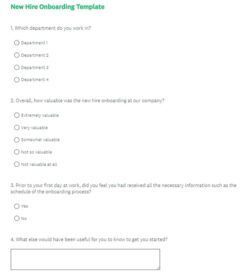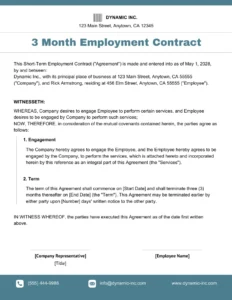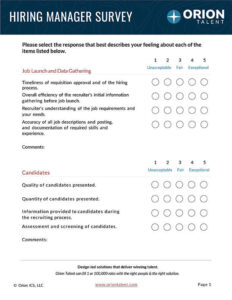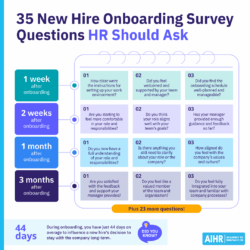Starting a new job is a big moment for anyone, filled with anticipation, a bit of nervousness, and a whole lot of new information. For companies, it is an equally critical period. A well-designed onboarding process sets the stage for a new hire’s success, engagement, and long-term retention. But how do you know if your onboarding is truly effective? The answer lies in listening to your newest team members. Gathering feedback during this crucial phase is not just a nice-to-have; it is an essential part of refining your processes and ensuring every new hire feels welcomed, supported, and ready to contribute.
An employee onboarding feedback survey template provides a structured way to collect these invaluable insights. It helps you pinpoint what is working well, identify areas that need improvement, and ultimately create an even more positive and productive experience for everyone who joins your organization. By systematically asking the right questions at the right time, you can turn new hire feedback into actionable steps that strengthen your company culture and boost overall employee satisfaction from day one.
What Makes an Effective Onboarding Feedback Survey?
Creating an effective onboarding feedback survey goes beyond just asking a few generic questions. It requires thoughtful consideration of the entire new hire journey, from the moment they accept the offer to their first few months on the job. A truly valuable survey captures insights across various touchpoints, ensuring you get a holistic view of their experience. Think about the administrative processes, the cultural integration, the training they receive, and the support from their manager and team. Each of these elements plays a vital role in how quickly and successfully a new employee integrates.
The best surveys are designed to be easy to understand, quick to complete, and non-threatening, encouraging honest and open responses. Anonymity is often key here, as it allows new hires to share their true feelings without fear of repercussions. You also want to ensure the questions are specific enough to provide actionable data, rather than just vague sentiments. For example, instead of asking “Was training good?”, you might ask “Did the initial product training adequately prepare you for your role’s responsibilities?”
Structuring the survey into logical sections based on the onboarding timeline can also enhance its effectiveness. This allows you to track progress and identify issues that might arise at specific points. For instance, you could have questions about pre-boarding paperwork, the first day experience, the first week’s training, and the first month’s integration with the team. This phased approach helps you pinpoint exactly when and where improvements are needed most.
Key Areas to Cover in Your Survey
When developing an employee onboarding feedback survey template, consider including questions that cover these crucial aspects of the new hire experience:
- Pre-boarding Experience: Questions about the clarity of initial communications, paperwork process, and first impressions before starting.
- First Day and Week: Focus on the welcome received, initial setup (IT, workspace), clarity of immediate tasks, and introductions to the team.
- Role and Responsibilities: Enquire about understanding of job expectations, availability of necessary resources, and initial training effectiveness.
- Manager and Team Support: Ask about the support from their direct manager, the helpfulness of colleagues, and feeling part of the team.
- Company Culture and Values: Gauge how well they feel the company values are demonstrated and how easily they are integrating into the workplace culture.
- Overall Experience and Suggestions: Open-ended questions for general feedback, suggestions for improvement, and a rating of the overall onboarding process.
By covering these areas, you ensure a comprehensive evaluation of your onboarding program, leading to more informed and impactful improvements.
Transforming Feedback into Actionable Improvements
Collecting feedback through your employee onboarding feedback survey template is only the first step. The real value comes from what you do with that information. Ignoring feedback, or simply filing it away, defeats the entire purpose of conducting the survey. The goal is to analyze the responses, identify trends and common themes, and then translate those insights into concrete actions that enhance the onboarding experience for future hires. This continuous improvement loop is what separates good onboarding programs from truly exceptional ones.
Start by regularly reviewing the survey responses. Look for patterns in the data: are multiple new hires struggling with the same piece of software setup? Is there a consistent suggestion for more detailed information about benefits during the first week? Highlighting these recurring issues allows you to prioritize which areas need immediate attention. Quantitative data can show you “what” is happening, while qualitative comments explain “why” it is happening, providing crucial context for your action plan.
Once you have identified areas for improvement, it is important to involve relevant stakeholders in developing solutions. This might include HR, IT, departmental managers, or even team leads. Collaboratively brainstorming fixes ensures that the changes are practical and sustainable. For example, if new hires consistently report confusion about their first week’s schedule, you might create a more detailed, pre-distributed itinerary. If IT setup is a common pain point, perhaps a pre-prepared laptop and access credentials can be arranged before their first day.
Finally, and crucially, communicate the changes you have made based on the feedback. Even if you do not explicitly mention that a new policy or process came directly from survey responses, demonstrating that you are actively working to improve the new hire experience sends a powerful message. It shows that employee voices are valued and that the company is committed to continuous improvement. This builds trust and encourages future honesty in feedback, reinforcing a culture of open communication and responsiveness.
Implementing changes is an ongoing process. After making adjustments, continue to monitor subsequent survey results to see if the changes have had the desired effect. This iterative approach ensures your onboarding program remains dynamic, relevant, and highly effective, consistently adapting to the needs of your incoming talent and setting them up for long-term success.
Investing time and effort into a robust onboarding feedback system pays dividends in the long run. It is a proactive approach to employee retention and engagement, ensuring that your newest team members feel valued and supported from the very beginning of their journey with your company. By continuously refining your processes based on real experiences, you build a stronger foundation for individual success and organizational growth.
Ultimately, a well-managed onboarding process, informed by honest feedback, contributes significantly to a positive employer brand and a thriving workplace culture. It demonstrates a commitment to employee well-being and professional development, making your organization an even more attractive place to work.



